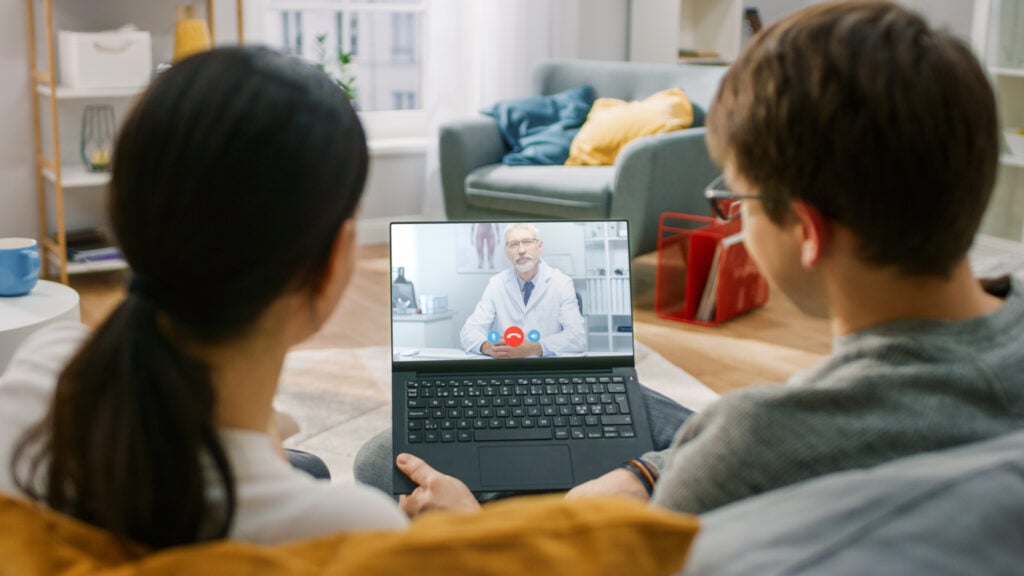Tele-optometry allows for a more convenient patient experience by providing optometry services remotely rather than in person. If you can access a smartphone, tablet, or computer, you can have a telehealth eye exam from the comfort of your home.

Telehealth eye exams allow you to meet with your doctor and ask them questions without making a trip to the office. You schedule an appointment online with your eye doctor and attend the virtual meeting during the chosen time.
Telehealth eye exams are not the same as digital eye exams. They both use new technology, but digital eye exams involve using this equipment in person.
What Can Tele-Optometry Services Help With?
Tele-optometry can help provide routine exams and diagnose certain eye diseases and infections.
They are also very accurate at diagnosing:1
- Conjunctival hemorrhage
- Zonal degeneration of the cornea
- Eyelid tumors
- Pterygium
- Corneal scarring
- Keratitis
As technology develops, new use cases for tele-optometry will be discovered.
What Are the Limits of Tele-Optometry?
Telehealth eye exams are convenient, but they aren’t a replacement for comprehensive eye examinations at your eye doctor’s office.
Telehealth visits can’t detect problems inside your eye. Your eye doctor will need to dilate your pupils to examine the inner parts of your eye, such as the retina.
Dilated eye exams are important for early detection of macular degeneration and other conditions that affect the retina.
How Remote Eye Exams Work
A telehealth eye exam is similar to an in-office test but much more convenient because you don't have to leave home. However, the main disadvantage of tele-optometry is that eye exams are less detailed than in-office exams.
A tele-optometry eye exam typically consists of three steps, including:
1. Collect Patient Information
Your optometrist will ask a series of questions before beginning the eye exam. These questions may consist of those related to your insurance, medical history, allergies, and medications.
They will also ask if you have a history of certain eye diseases and conditions, such as:
2. Perform an Eye Exam
After the information is updated, the licensed optometrist will move on to the pre-screening exam. It’s essential to have proper high-speed internet access to ensure the video is high-quality.
The pre-screening portion of a remote eye exam may include the following tests:
- Autorefraction. This test uses an autorefractor-keratometer to get an estimate of your eyeglass prescription.
- Lensometry. This test verifies the prescription in your current eyeglasses.
- Retinal imaging. This imaging test takes a detailed picture of the back of your eye with a fundus camera. It takes an image of your retina.
- Non-contact tonometry. This test takes your eye pressure as part of a glaucoma screening.
- Subjective refraction test. This occurs after the pre-screening tests. This is to determine your eyes' best-corrected visual acuity (BCVA).
3. Review Exam Results & New Prescription
After the pre-screening tests and eye exam, your eye doctor will discuss your eye health status and any concerns.
They will recommend new contact lenses and glasses if your prescription changes. You can order the new lenses directly from your eye care provider or buy them online.
Are Remote Eye Exams as Accurate as In-Person Exams?
Studies show that most patients are satisfied with tele-optometry and find it comparable to a gold-standard, in-person comprehensive eye examination.5-6
Tele-optometry is proven to be an accurate way to determine a person’s vision prescription. One study found no significant difference in patients’ prescriptions between tele-optometry and in-person comprehensive eye exams.5
Summary
Tele-optometry exams are eye appointment exams conducted virtually. They're a great option for those who don't have the time to go to a doctor's office. While tele-optometry exams offer various benefits, remember that they still have limitations.
In this article

